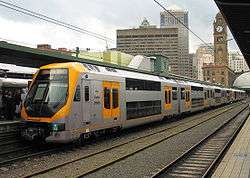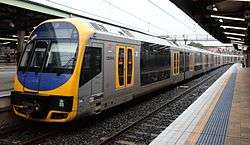Rail rolling stock in New South Wales
The railways of New South Wales, Australia, use a large variety of passenger and freight rolling stock.
Suburban passenger rolling stock
The first railway in Sydney was opened in 1855 between Sydney and Granville, now a suburb of Sydney but then a major agricultural centre. The railway formed the basis of the New South Wales Government Railways. Passenger and freight services were operated from the beginning. By 1880, there was a half hourly service to Homebush.
Former Stock
Single-deck cars
1920 wooden single-deck cars

In the 1920s, the Bradfield electrification program began. Until then, trains continued to be sets of steam-locomotive-hauled wooden end-platform cars. In 1921, 101 wooden bodied driving-motor cars (later numbered C3000–3100) were built by Ritchie Brothers and Meadowbank Manufacturing Company C3045 (now preserved) was built by the railway workshops as a prototype, but became the very last to enter traffic in 1923. They were originally steam-hauled EBB/EFA cars, prior to conversion to electric traction with the opening of the first section of electrified line between Sydney and Oatley in 1926. These wooden cars had steel sheathing for additional strength, and became known as the Bradfield cars. Some Bradfield cars were converted to parcel vans after accidents. Other Bradfield cars were rebuilt to resemble Standard suburban (1927-type) cars in the 1960s, to prolong their lives until new double-deck cars could be delivered to replace them. The last Bradfield power-cars were withdrawn from service in 1975. C3045 is preserved static at the NSW Rail Museum, Thirlmere, while C3082 has been retained by RailCorp. C3082, the former Elcar "Pilot" Shunter, was used on a number of single-deck railfan tours in the 1980s, often with Wooden trailer car T4279.
At the same time, 193 steam-hauled end-platform cars were rebuilt into 184 electric trailer cars (T4101–4284) and nine driving trailer cars (D4001 to 4009). They were in service much longer than intended, being finally replaced by the Tulloch single deck, and later double-deck, trailers from the 1950s onwards. D4001 and 4006 were converted to Parcel Vans driving trailers. T4279 is preserved and has been used on many railfan single-deck tours in the 1980s and early 1990s. D4004 is also preserved awaiting restoration, but not operable. [1]
1925 all-steel cars
With the planned opening of the Sydney underground lines and electrification, it was proposed to build steel bodied suburban cars. As no such cars were built in Australia before, an initial 50 cars (numbered 3101–3150) were built by the Leeds Forge Company in England and assembled at Eveleigh Carriage Workshops and Clyde Engineering between April and October 1925. Initially numbered 2213–2262, they entered service being inserted into sets with Bradfield carriages for haulage by steam locomotives until fitted with Metropolitan-Vickers electrical equipment and motors in 1926. At this stage they were renumbered C3101 to C3150.[2][3][4]
1926–1960 single-deck steel cars

Between 1926 and 1960, a total of 417 motor cars and 417 trailer cars were built by various contractors including Leeds Forge Company, Walsh Island Dockyard, Clyde Engineering, Tulloch Limited and Comeng. The pre-war "1927 type" cars were known as the "Standard" cars as they dominated the suburban fleet, and featured First and Second Class travel until 1 January 1940. More cars (the majority being trailer cars), were delivered by Tulloch Limited between 1940 and 1957 to cater for system expansion, and to replace many of the decrepit Wooden trailer cars. The 80 cars built by Comeng from 1957 to 1960 (40 motor and 40 trailer cars) became known as the Sputnik cars. They had 4 single power operated doors on each side and were of spot-welded construction.[5] These cars were introduced at the time of electrification extension from Parramatta to Penrith. One 8-car set of Tulloch cars was fitted with power-doors and ran from 1956 to 1976 as set F39. Between 1968 & 1973, 97 Standard & Tulloch motor-cars were converted from two to four motors on new air-ride bogies for better performance and adhesion, starting with C7500 (ex C3500). These single deck electric multiple unit (EMU) sets were the backbone of the Sydney suburban network until the stainless-steel double deck cars of the S (and later C, K & R) sets took over. The last of the Sputniks had their final retirement in 1993. Many cars were painted blue & white during the PTC years from 1972 onwards, and the last blue & white cars were repainted in 1987. Several cars were fitted with Beclawat sliding windows during overhauls as a cost-cutting measure (see photo). After 1976, they carried a deep 'Indian Red' livery until their retirement. In 1991, one eight-car set H22 was painted in a special livery to promote Taronga Zoo. Two power-door W-sets were painted in special liveries for the Zoo (W1) and to mark Sydney's Sesqicentenary (W2). Many of the motor cars were marshalled with the Tulloch double deck trailer cars (see below) to form 4 or 8 car mixed single and double deck sets.[6] In their final years, these cars became associated with the term 'red rattlers' by the State Government and the media, due to the way the windows and window shutters rattled in their frames. On 10 June 2016, Preserved cars C7396, T4527, C3218 and C3426 were returned to operational status by Sydney Trains in conjunction with Historic Electric Traction. This train set, now known as Red Set F1, operates occasional special passenger trips through Transport Heritage NSW. At 90 years of age, Set F1 is now among the oldest fully operating electric train sets in the world.[7]
Double-deck cars
1964 Tulloch double-deck trailers (1964–2003)
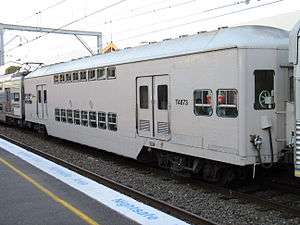
In the 1960s, tenders were called for double-deck electric passenger cars. In 1964, the first of 120 Tulloch trailers were delivered,[8] and integrated into the single-deck sets. The cars were built by Tulloch Limited, and were numbered 4801–4920, by operating across only the City Circle, South, Bankstown, East Hills and Inner West Lines (Sector 2). They consisted of normal floor level over the bogies, with a double deck passenger section between the bogies. The cars were largely riveted aluminium, with steel underframes. They carried green internal livery and were painted Tuscan Red on the outside sides with painted silver roofs to match the single deck carriages. For the first time in Sydney, fluorescent internal lighting and air suspension bogies were used. The initial 40 cars were used in power door sets, the remainder in non-powered door sets, and they replaced the remaining wooden bodied trailer cars. In 1987, W-set trailers T4834–4838 were converted to manual door M-set cars by having their power-doors disconnected, and rewired from 120- to 32-volt operation. The Tullochs were painted in the colour scheme of the day (blue & white and later deep Indian red). Cars T4839 to 4895 were later painted grey and marshalled into sets containing Comeng & Goninan double-deck cars (see below) as 'R & S sets'. Cars T4834–4838 and 4896–4920 continued to operate with older single-deck motor cars as 'M Sets'. The W set trailers (T4801–4833) and M set trailers (T4834–4838 and 4896–4920) were withdrawn in 1994 with the retirement of all single deck suburban stock, the cars marshalled with Comeng power cars in W sets saw service until February 2004, before the introduction of the Millennium Trains. Cars 4801, 4814, 4840, 4843, 4844, 4849, 4850 4854, 4874, 4881, 4799 have been kept for preservation.
1968 prototype double-deck power cars (1968–1980)
In 1966, after the success of the Tulloch double-deck trailers, tenders were called for double deck motor cars. In 1968, four experimental double-deck motor cars (C3801–3804) were built by Tulloch and entered service[9] enabling the first eight-car double-deck train, set S10, to operate by marshalling them with four Tulloch trailers T4839, 4840, 4843 and 4844. These were the first fully double-deck Electric Multiple Unit passenger trains in the world.
Each power-car carried electrical equipment from different manufacturers for evaluation purposes: C3801 (Mitsubishi), 3802 (Toshiba), 3803 (Hitachi) and 3804 (English Electric). Set S10 proved unreliable[10] and the single-deck "Sputnik" C3701-series power-cars often deputised for Tulloch power cars out of service. In 1977, it was decided to disband the set to convert them to trailers. C3801 was converted to T4797 in 1980 and C3803 became T4799 in 1982. Conversion of C3802 to T4798 was started at Elcar Workshops, but never finished and it was later scrapped. C3804 is now preserved at the NSW Rail Museum, Thirlmere. It was withdrawn from service on 4 January 1980.[11]
These trailers operated on the:
- South Line – City Circle to Macarthur via Granville
- Inner West Line – City Circle to Liverpool via Regents Park
- Bankstown Line – City Circle to Liverpool via Bankstown
- East Hills Line – City Circle to Macarthur via Sydenham (then via Airport Line in 2000–2003)
1972 Comeng power cars
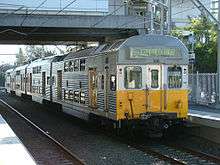
In 1972, the first Comeng-constructed stainless steel double deck power-cars entered service. These cars (C3805–3857) were loosely based on the recently introduced inter-urban cars, the V set. Their stainless-steel bodies were painted the standard "Tuscan red" to match the livery of the existing fleet. Cars C3844–3857 were delivered in the blue and white livery of the Public Transport Commission in the 1970s, and repainted to deep Indian red after 1976, before being paint-stripped to run in their original stainless steel finish in the early 1980s. They were initially marshalled into sets (from S11 onwards) with Tulloch trailers T4841, 4842, and 4845 to 4895, which had their passenger doors modified from manual to power operation. Internally, they had reversible seating with a light-tan upholstery, and a grey and off-white internal livery. Beclawat sliding windows were fitted to the upper and lower decks, with drop windows in the doors. The sliding windows were replaced with Hopper windows in the 1990s and internally they were repainted light grey with blue upholstered seating. These motor cars had tapered ends, which were fitted with destination boards in the 1990s. With the introduction of the Millennium Trains in 2002, several early Comeng power-cars were converted to non-driving trailers, with their pantographs removed, and renumbered T4701–4723.
1973 Comeng power and trailer cars
In 1973, additional 54 Comeng power cars C3858 – 3911, and 56 Comeng trailer cars T4921 – 4962, were ordered to coincide with the opening of the Eastern suburbs railway line. These trailer cars were the first to be of stainless steel construction, and they had an extra row of seats on the top deck (and are thus distinguished by an extra single window at the centre of the car on both decks). Ten driving trailers D4011 – 4020 were built with small driver's compartments for 2-car trains. However, they never saw service as driving cars due to Union bans. Subsequently, 25 driving trailer cars D4021 – 4045 (with large guard's compartments) were also built to be paired with a driving motor car to allow 2-car sets to be operated. Ten driving trailers were diesel hauled on South Coast suburban services, south of Thirroul, prior to electrification. Ten driving trailers, renumbered D4001 – 4010, were used for two car shuttles in the initial period after the electrification of the Richmond line. These driving trailer cars subsequently had their driving equipment removed and were converted into standard non-driving trailer cars.[12] Extended orders saw the Comeng double-deck fleet expanded to include power-cars C3912–3986 & 3741–3765, trailers T4963–4987 and driving trailers D4046–4095 by 1982. By 1976, one quarter of suburban cars were double deck. All the 1973 cars are now integrated with earlier stock and operate as L, R & S Sets. With the introduction of the Millennium Trains in 2002, several early Comeng power-cars were converted to non-driving trailers, with their pantographs removed, and renumbered T4701–4723.
1978 Goninan cars
In the 1970s, A Goninan & Co in Newcastle entered the passenger car construction market building 80 power cars C3001 – 3080 and 70 trailer cars T4101 – 4170. Unlike the Comeng cars, the power cars had a flat front end and Pullman Standard fluting, and the upper deck passenger windows were set significantly lower than the earlier Comeng cars reducing passenger sight lines (a source of complaint from passengers).[12] When the Eastern Suburbs Railway was opened in 1979, only stainless-steel Comeng or Goninan double deck cars were meant to operate on this line, but the painted Tulloch double-deck trailers were also used. In 1981, a brand new four-car Goninan set conveyed Queen Elizabeth II from Bankstown (which was declared a City by the Queen) to Martin Place. For this occasion the train was specially fitted out with carpets and other refinements. The set was targeted "R1" for the occasion. These cars continue to operate in 2007 as L, R and S sets. They are the only non-air conditioned passenger trains in service in Sydney.
Two thirds of pre-1981 non-air conditioned rolling stock were withdrawn from service with the roll-out of 626 new A set Waratah carriages (78 sets) from 2012 to June 2014. The final sets were scheduled to be withdrawn from service by 2015 but some sets were retained for the South West Rail link since no newer rollingstock or additional Waratah trains had been ordered. In December 2016, the NSW Government announced a plan to introduce 192 new Waratah carriages also known as the Sydney Trains B sets. These have replaced the remaining non-airconditioned S set trains by the end of June 2019[13]
Current Stock
1981 Goninan power and trailer cars
In 1981, Goninan built the first air-conditioned cars for the Sydney suburban network. Until then, Sydney had lagged somewhat behind other cities that had commenced the introduction of air-conditioned stock. In order to fit the air-conditioning equipment into the motor cars, the pantographs were moved to the trailers, effectively meaning that a motor car must remain semi-permanently coupled to a trailer car. Four driving trailer cars D4096–4099 were also ordered, allowing 2-car sets to be operated with power cars C3501–3504. The first 8-car set (R1) was delivered with air-conditioning, followed by 90 forced ventilation cars C3505–3549 & T4171–4215, during the delivery process for this order, C3550 and T4216 were delivered, fully fitted with air-conditioning.
Following this, the next order, numbered from C3551 and T4217, were also fitted with forced-air ventilation, and were the first to be fitted with air-conditioning. The first 100 cars had their upper deck windows at the unpopular lower height of the earlier Goninan cars, the final 60 were modified and these final 60 were distinguished by their front end being painted into the 'candy' white, orange and red State Rail livery of the time. The final batch (C3551-3580 & T4217-4246) also featured bright yellow internal walls. The forced ventilation cars were later retrofitted with air-conditioning, and the Beclawat sliding windows replaced by fixed panes in the late 1990s. Also at this time, the standard light grey internal livery was adopted, and the seats were replaced with blue upholstery.[14] 160 of these cars were delivered until 1985, and continue to operate in 2011 as K sets.
1985 Goninan cars
In 1985, a new generation of advanced suburban passenger train was being considered by the State Rail Authority. There was a delay in the construction of these trains, and 56 interim stainless steel air conditioned cars, C3581–3608 and T4247–4274, were built by Goninan, known as the 'Chopper Cars' for their chopper control. These cars trialled several features of the next generation cars, such as fixed seating, door chimes and passenger address systems. They were originally fitted with a push-button feature, to enable passengers to open the doors manually, but this feature was short-lived. They retained the flat ends of the previous Goninan cars, but with the addition of a fibreglass moulded end piece which was originally white with orange and red stripes (the 'candy' State Rail livery). These ends were later painted grey with a lower yellow section which they retain to this day, and internally the standard grey livery and blue seat upholstery was applied.[14] These cars continue to operate as C sets.
Tangaras
_suburban_train.png)
In 1988, the "third generation" train, called Tangara – an aboriginal word meaning "to go", was introduced. This train marked a radical departure from the previous double deck car design both in appearance and technically. The Tangara is the last publicly funded electric rolling stock built for CityRail – all future electric trains are being built and operated under public–private partnership agreements. A total of 450 T set cars were introduced between 1988 and 1994, allowing the withdrawal of the remaining single deck suburban passenger cars in 1993.
Eighty G set cars featuring toilets, high-backed reversible seating and passenger door opening controls were built between 1994 and 1996. These generally operated on outer-suburban runs, typically to Wollongong, Springwood and Gosford, though they also sometimes operated in suburban service. These outer-suburban sets allowed the retirement of the last remaining single-deck U sets in 1996. One set, G7, was experimentally fitted with dual-voltage A/C traction. This set was extensively damaged in the Waterfall rail accident in January 2003 and scrapped after completion of the coronial inquiry into the accident.
In 2010, a refurbishment program began for all Tangaras, which were by then nearly 20 years old and showing signs of wear and tear. This work involved reupholstered seats, new flooring and handrails, relocated end saloon partitions and a complete internal repaint. Inter-car doors and handrails are repainted yellow, and the interiors share common fittings with the Millennium and OSCAR cars. The former outer-suburban G sets have been retargeted as T sets from T101 onwards and the cars recoded from OD, ON and ONL to the suburban D & N codings, retaining the same 58xx and 68xx number series. The former ONL cars have had their toilet and water cooler removed and replaced with longitudinal seating, but without the luggage racks found elsewhere in these cars.
Millenniums
From 2002, 140 "fourth generation" carriages were introduced, known as Millennium trains or M sets. These trains allowed the withdrawal of the Tulloch trailer cars. These were the first passenger trains in NSW to introduce automatic passenger information displays and announcements. The design of the M sets formed the basis for the design of H sets and A sets. These trains are maintained by Downer Rail at the Auburn Maintenance Centre.
While the Millennium trains are suitable for division into four-car sets, they are normally kept coupled as eight-cars sets at all times.
Waratahs
.jpg)
The Waratah sets (also called A sets) are a double-decker, air-conditioned train based on the Millennium train, the order being for 78 sets of eight cars per train. The body shells were constructed in China and completed at Newcastle, New South Wales by a joint venture between the NSW Government, Downer Rail, and other companies under a public–private partnership, with delivery between 2011 and 2014 to replace the now withdrawn 6-8 car R & S Set trains. The first set went into regular service on 1 July 2011 on the Macarthur–East Hills–Airport line with the last set delivered by mid-2014.
The New South Wales Government announced on 1 December 2016 that 24 new suburban trains had been ordered. Known as the Sydney Growth Trains during development, the trains are officially classified as B sets and are also known as Waratah Series 2 trains.[15][16] The $1.7 billion contract was awarded to Downer EDI. CRRC Changchun Railway Vehicles manufactured and delivered the bodies of the trains to Downer EDI, which assembled them.[17][18] More than 90 percent of the design is shared with the original Waratahs.[19][20][21][22] The first B set was unveiled in Auburn in March 2018. After undergoing months of testing, Set B2 was the first to enter revenue service on 7 September 2018.[23] The B sets replaced the remaining S sets by the end of June 2019.[24][16] In February 2019, a further 17 B sets were ordered with deliveries to start in September 2020, but due to the Coronavirus (COVID-19) pandemic, the trains are likely to enter service in 2021.[25]
Sydney Metro rolling stock
Alstom Metropolis TS sets
.jpg)
22 Sydney Metro Alstom Metropolis 6-car sets entered into service when the Sydney Metro opened in May 2019.
Inter-urban passenger rolling stock
Former Stock
Single-deck interurban cars
_at_the_Junee_Roundhouse_Museum.jpg)
The initial 80 electric interurban passenger cars (40 "CF" power cars 5001–5040, 20 "TF" trailer cars 6001–6020 and 20 "ETB" trailer cars 6021–6040) were introduced from 1958 to coincide with the electrification of the Blue Mountains line to Bowenfels. These trains were similar in external appearance to the single deck steel suburban cars but were slightly narrower (for 2+2 across seating), built of unpainted stainless steel and corridor connectors between the cars. These trains carried a 'U' target plate, and became affectionately known as 'U Boats'. They featured First and Second Class accommodation until 1974, when they became "one class". First Class (in the ETB trailers) was identifiable by blue covered seats (as opposed to green seats in second class), carpet on the floor and ashtrays in the smoking section. Their operational sphere spread from Lithgow/Bowenfels and Gosford to include Port Kembla, Dapto and Newcastle until their final demise in 1996. They have been used on many railfan tours since the 1960s, sometimes loco-hauled outside the electrified area. Three power cars and two trailer cars have been preserved by the Sydney Electric Train Society.[26] Other U-boat cars have been preserved privately, and many sold to private buyers for a variety of uses after withdrawal.
620/720-class diesel rail motors
Eighteen two-car self-propelled 620/720 class railcars were introduced between 1961 and 1968, constructed at the New South Wales Government Railways' Chullora Railway Workshops. They were the final passenger railcars to be built by government workshops in NSW.[27] They were based on the 600/700 and 900/800 class railcars and were built for Newcastle suburban and regional workings, although they saw service on Wollongong services before electrification, and rural services to Cowra, Mudgee, Grafton and Murwillumbah.[28] Three sets were built with first and second class accommodation and were used for country services, the remainder were single-class only (originally designated second class). They have served the non-electrified and pre-electrified sections of the Sydney suburban and outer-suburban (interurban) passenger networks – they saw service on the Richmond line until completion of electrification works in the 1990s. After the removal of many country services and the electrification of the South Coast Line in 1985 and the Richmond line in the 1990s, they saw service on the Far South Coast line and the Southern Highlands line. At introduction, they were painted tuscan red. From the 1970s, some carried an Indian red livery. In 1980, some were painted in a reverse livery with yellow front ends. From 1982 the 'candy' livery of bright red, with orange, yellow and white trims was introduced system-wide and the 620/720 class were no exception. In the 1990s, they were repainted from 'candy' into a 'heritage' livery reminiscent of the former tuscan paint scheme, before adopting a grey and blue corporate CityRail livery in the 2000s. After the introduction of the Endeavour railcars in 1994, their numbers were reduced to seven two-car sets, and they were all withdrawn from service during 2007.
Several of these sets have been preserved, with 621/721 repainted into 1960s deep Indian red livery with buff lining by the Rail Motor Society. This set has already seen use on enthusiast tours. At least one other set is under restoration to original external and internal condition.
Current Stock
Double-deck inter-urban cars
V Set
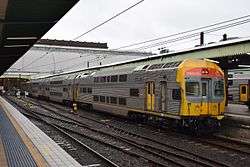
Introduced from 1970, these double deck interurban cars actually predated the first full suburban double deck sets. Described at the time as the 'most luxurious commuter stock in the world',[29] they set new benchmarks for passenger comfort in Sydney. Initial service was confined to the Central Coast & Newcastle Line until they were usable on the Blue Mountains Line after the Glenbrook tunnel was widened in 1975. They could proceed as far as Lithgow after the Lithgow tunnels were widened in 1979. Services began on the Illawarra line after electrification in 1985. Initially these sets carried 'U' target plates. The subsequent orders of double-deck cars carried 'V' plates to designate sets fitted with vacuum toilets. The original 1970 cars were not a success, and they were rebuilt into trailers to run with the later-series intercity cars in the early 1980s. These later cars can be identified by seating with plastic orange surrounds, and they lack a door between the passenger compartment and the small entry/exit area. The second series of the V-Sets (DCM/DM) commenced being phased out in early 2011, to be replaced by the Oscar. When NSW TrainLink was established in 2013 the V sets were subject to refurbishment program involving the repainting and refitting the interior and new exterior livery.[30] The rest of the V sets are expected to begin being replaced by 2024 when the D sets are introduced.[31]
OSCAR
H sets (OSCARs, an acronym for Outer-Suburban CARs), were launched on 24 April 2006. The H sets were principally built to replace the G set Tangaras on outer-suburban services and the original order of V sets. They feature identical reversible seating to Hunter railcars, and one disabled toilet per four-car set, whilst the vestibules feature longitudinal seating and ceiling hand-grips. They run to Newcastle Interchange, Port Kembla and Kiama. These cars were built by UGL Rail. When the D sets are introduced, the H sets will also be displaced and moved onto the Sydney Trains suburban network.
Single Deck Interurban Cars
Endeavour railcars
.jpg)
28 Endeavour diesel railcars were introduced from 1994 to operate the non-electrified CityRail lines to replace the ageing DEB railcars and some of the 620/720 class railcars. They currently operate on the Southern Highlands line, the Illawarra line between Kiama and Bomaderry, the Bathurst Bullet on the Main Western line and the Hunter line. They previously operated weekend service on the Moss Vale – Unanderra line. They operate as two or four-car sets. Several cars were converted into Xplorers, which they are technically and mechanically identical to.
Hunter railcars
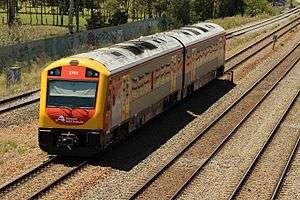
In 2006, 14 Hunter diesel railcars were ordered to replace 620/720 class railcars. They are a new type of diesel multiple unit used on the Hunter Valley lines centred on Newcastle. The Hunter railcars were built by United Goninan and are sharing Newcastle to Maitland, Telarah and Dungog regional services with Endeavour railcars. The design is derived from the new generation Transwa Prospector, except that the lower top speed requirement for the Hunter railway line means that the driving cars are each single-engined instead of dual-engined.
Country passenger trains
Former Stock
CPH (Tin Hare) railmotors
The CPH railmotors were introduced from 1923 to provide feeder services on country branch lines.[32] They operated many branch line services in the south of the state until their widespread withdrawal in 1974.[33] They also provided pre-electrification service on the Richmond line, late night Clyde – Carlingford shuttles, Sutherland – Waterfall on the Illawarra line and Pippita & State Abattoirs line in suburban Sydney until they were officially withdrawn with the 27 November 1983 timetable. A handful of CPH railmotors worked Wollongong suburban services for some months afterwards. Many of these veteran rail motors are preserved and still operational. Following the failure of 620 railcars to fit through the Fernleigh tunnel, the CPH railmotors also provided passenger service from Newcastle to Belmont.
Creamy Kate and Trailer
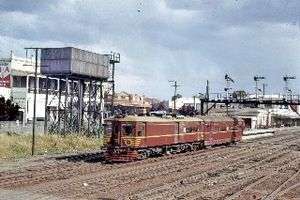
After an accident at Bowning, in which several passenger cars were damaged, two underframes were salvaged. Around the two underframes, a two-engine railmotor and attendant trailer were constructed. The motor car was allocated number CHP38 and the trailer 81. It spent most of its days on branch lines out of Narrandera. Trailer 81 was ultimately rebuilt and renumbered FT551 and worked Sutherland to Waterfall shuttles with conventional CPH railmotors until electrification in July 1980.[34]
Silver City Comet
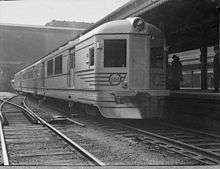
These self-propelled diesel passenger trains were introduced in 1937 and operated between Parkes and Broken Hill.[35] During World War II, they were also used on some intercity runs from Sydney to Canberra and Newcastle. Together with Victorian Railways' "Spirit of Progress", it was the first air-conditioned train in the British Empire.
When introduced, it was originally painted silver, to reflect the harsh heat of the western plains. After World War II, Silver City Comet sets were repainted in standard NSWGR tuscan & russet, then Indian red liveries. Prior to the 50th anniversary of the Silver City Comet in 1987, it reverted to the original silver livery. The Silver City Comets were withdrawn in 1989.[36] The majority of the remaining Silver City Comet fleet has been preserved in static condition.
900/800 class diesel rail motors
Ten 600/700 class diesel rail motor sets were introduced from 1949 to operate country passenger branch lines, the first such service being from Dubbo to Coonamble.[35] From 1955 until 1990, air-conditioned 800/900 class trains, known as DEB sets, provided service to Canberra as the Canberra Monaro Express, replacing the steam hauled Federal City Express.[37] The DEB sets were also used on some South Coast Line and Southern Highlands Line commuter services until they were replaced by Endeavour railcars in 1994.
Current Stock
XPT
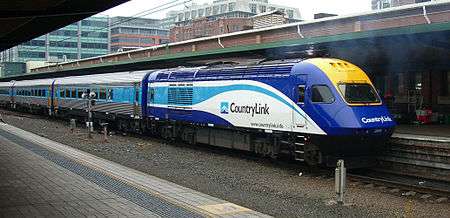
The XPT (express passenger train) is the mainstay of the NSW country passenger rail-network. Modelled on the British HST and introduced from 1982, they currently provide service from Sydney to Melbourne, Brisbane, Dubbo, Grafton and Casino.[38] An XPT consist can vary between four and seven cars depending on demand. Initially, the XPT was painted in a livery that was predominately red, with black and orange was also used in the livery and InterCity XPT signwriting on the power cars. The initial impact of the XPT's striking livery provided the inspiration for the "candy-stripe" livery to be applied to SRA locomotives and the interurban & country passenger car fleet from 1982. The first CountryLink repaint was introduced in 1991, and was updated to a new CountryLink livery in 2008. Class leader XP2000 has appeared in a number of special liveries for Sydney 2000 Games[39] and the 2001 Centenary of Federation. In the early 1990s, XAM sleeping cars were added to the interstate XPT consists after protests arising from the cancellation of the locomotive hauled sitting & sleeping car trains Brisbane Limited and Pacific Coast Motorail in 1990.
Xplorer
.jpg)
The Xplorer is a diesel self-propelled multiple unit train, introduced from 1993. They provide services to Canberra, Griffith, Moree, Armidale and Broken Hill. They are technically and mechanically similar to NSW TrainLink's Endeavour railcars, but with a buffet service and a higher standard of accommodation.
Codes
|
Letters of passenger vehicles often have the following meanings:
|
Electric vehicles use the following letters:
Suburban EMU carriages use one letter codes. Inter-urban EMU carriages use two or more codes.
|
Fleet
- A = Waratah Series 1
- B = Waratah Series 2
- C = Chopper C set
- H = OSCAR (Outer Suburban Cars)
- J = Hunter Railcar
- K = K Set
- L = L set, post 1988
- M = Proposed for the Tangara, later changed to T set. Millennium
- N = Endeavour (possibly given due to the silent E in its name)
- P = Xplorer
- R = R set (withdrawn)
- S = Tulloch carriage stock (single and double deck), see W set. S Set (withdrawn)
- T (G) = 2 car S set, see L set. Tangara (given due to the first letter of its name)
- V = V set (given due to its vacuum toilets)
- W = Tulloch carriage stock, post 1972. (given to free up the S allocation, possibly chosen because of the double deck coaches used in the sets, and the letter being used to signify 'double' in places such as Japan.)
- X = XPT (express passenger train)
- Y = 3 car V sets for DTRS/ATP testing -Not for passenger service
See also
References
- Survey of Sydney Electric Trains, 1926–1960, Part 1. Australian Railway Historical Society Bulletin, March 2001
- Churchman, Geoffrey (1995). Railway Electrification in Australia & New Zealand. Smithfield: IPL Books. pp. 85, 92.
- "Sydney's Electric Trains from 1926 to 1960" ARHS Bulletin issue 761 March 2001 pages 90-93
- C3104 - 1925 Leeds Forge Standard Motor Car Sydney Electric Traction Society
- The Sputnik Cars SETS Library
- Survey of Sydney Electric Trains, 1926–1960, Part 2. Australian Railway Historical Society Bulletin, May 2001
- "Welcome to HET". het.org.au.
- The Double-Deck Suburban Cars Singleton, C.C. Australian Railway Historical Society Bulletin, June, 1964 pp. 101–06
- New Double Deck Suburban Electric Power Cars Calf, H.R. Australian Railway Historical Society Bulletin, April, 1969 pp87-91
- Sydney's First Double Deck Train Moss, Geoff Australian Railway History, December, 2007 pp. 451–59
- "C 3804 - Tulloch Suburban Motor Car - NSW Environment & Heritage". www.environment.nsw.gov.au.
- Sydney Suburban Fleet, Part 2. Railway Digest, July 2002
- "End of the line for the S-Set trains". Transport for NSW. 27 June 2019. Retrieved 27 June 2019.
- Sydney Suburban Fleet, Part 3. Railway Digest September 2002
- Asset Standards Authority. "Movement of Sydney Growth Trains (SGT) B Set cars between Woodville Junction and Sulphide Junction" (PDF). Transport for NSW. Retrieved 16 March 2018.
- "New air conditioned trains arrive". Transport for NSW. 22 March 2018. Retrieved 22 March 2018.
- O'Sullivan, Matt (1 December 2016). "$1.7 billion in new Waratah trains for Sydney commuter network". The Sydney Morning Herald. Retrieved 29 March 2018.
- "Rail". Downer Corporate Site. Retrieved 29 March 2018.
- McNally, Lucy (1 December 2016). "Sydney trains to receive $1.5b boost for services to western suburbs". ABC News. Australian Broadcasting Corporation. Retrieved 1 December 2016.
- "Rail revolution: 'More Trains, More Services' to bust congestion". Transport for NSW. 1 December 2016. Retrieved 1 December 2016.
- "More Trains, More Services" (PDF). Transport for NSW. Retrieved 1 December 2016.
- "Downer awarded Sydney Growth Trains contract". Downer Group. 1 December 2016. Archived from the original on 1 December 2016. Retrieved 1 December 2016.
- "7 News Sydney on Twitter". Twitter. Retrieved 22 October 2018.
- O'Sullivan, Matt (22 March 2018). "New Waratah trains finally signal end to Sydney's 'sweat sets'". The Sydney Morning Herald. Retrieved 22 March 2018.
- Sydney's stretched rail network in store for $900m in new trains Sydney Morning Herald 6 February 2019.
- "Single Deck InterUrban cars". SETS.
- Eade, W. 620/720: The Great Survivors. Railway Digest, November 2003
- Walters, C The Survivors: The 620 Class. Australian Railway History, March, 2007
- NSW Double-Deck Interurbans Turn 30, Railway Digest, June 2000
- "NSW Trainlink to deliver dedicated service for Intercity and Regional customers" Transport for NSW, 1 July 2013
- "NSW Government to invest $2.8 billion in new intercity trains, making all trains air-conditioned". Transport for NSW. Retrieved 8 May 2014.
- "Cooma Monaro Railway". Cooma Monaro Railway. Archived from the original on 8 April 2007. Retrieved 5 May 2007.
- Banger, C. The Intercapital Daylight, 1956–1991 Australian Railway Historical Society Bulletin, Vol 52 No. 764. June 2001
- Rail Motor 38 and Trailer 551 – The 55ft. Rail Motor Stock Preston, R.G. Australian Railway Historical Society Bulletin, March, 1971 pp66-72
- "Railway Service Provision Line". State Records NSW. Archived from the original on 8 September 2007. Retrieved 25 April 2007.
- "Hansard Legislative Assembly". Hansard, NSW. Retrieved 25 April 2007.
- "History of Railways in Canberra". ARHS ACT Division. Archived from the original on 4 April 2007. Retrieved 29 April 2007.
- TrainLink, NSW. "Our fleet | NSW TrainLink". NSW TrainLink. Retrieved 7 July 2017.
- "Special trains". www.railpage.org.au. Retrieved 7 July 2017.

.jpg)
